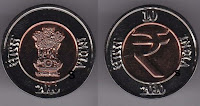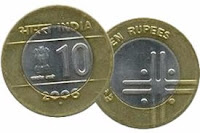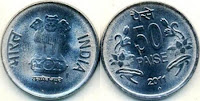India won its independence on the 15th of August, 1947. During the period of transition India retained the monetary system and the currency and coinage of the earlier period under British Sovereignty. While Pakistan introduced a new series of coins in 1948 and notes in 1949, India brought out its distinctive coins on August 15, 1950.
Republic of India Issues could broadly be categorized as:
The Frozen Series 1947-1950
This represented the currency arrangements during the transition period up to the establishment of the Indian Republic. The Monetary System remained unchanged at One Rupee consisting of 192 pies.
1 Rupee = 16 Annas
1 Anna = 4 Pice
1 Pice = 3 Pies
The Anna Series
Controversy over two-rupee cross coin
Commemorative Coins
Commemorative coins are coins that were issued to commemorate some particular event or issue. The first Indian commemorative coin was issued in 1964 to mourn the death of Jawaharlal Nehru. Such coins have a distinct design with reference to the occasion on which they were issued.
Commemorative Indian Coins are very interesting to discuss because they cover many topics like Indian Independence Struggle, War, Peace, Wildlife, Vegetation, Great Personalties, Various Events and Organisations. Denomination from 5 paise to 150 rupees.
Bimetallic coins
Indian rupees 10 bimetallic coins is the country first ever bimetallic coin ever released. The 10 Rupee coin was designed by National Institute of Design (NID), Ahmedabad with the theme of Unity in Diversity. The coins are being prepared at Noida and Mumbai mints.
New sign of Rupee coin series
New series of coins is released with improved design and revised size in the denominations of 50 paise, Re.1, Rs.2, Rs.5, and Rs.10. The new coins are of user-friendly size and weight, with improved counterfeit resistance, and the security edging of these coins would be good for better recognition by visually challenged persons. The present series of coins of 50 paise, Rs.1, 2, and 5 contain a flowery design and for Rs.10, the number of petals have been brought down to 10 in place of the existing 15 petals. The parallel lines on the obverse side of the Rs.10 coin have been removed and the size of Ashok Pillar has been increased.
Republic of India Issues could broadly be categorized as:
The Frozen Series 1947-1950
This represented the currency arrangements during the transition period up to the establishment of the Indian Republic. The Monetary System remained unchanged at One Rupee consisting of 192 pies.
1 Rupee = 16 Annas
1 Anna = 4 Pice
1 Pice = 3 Pies
The Anna Series
This series was introduced on the 15th of August, 1950 and represented the first coinage of the Republic of India. The King of England's Portrait was replaced by the Lion Capital of the Ashoka Pillar. A corn sheaf replaced the Tiger on the one Rupee coin. In some ways this symbolized a shift in focus to progress and prosperity. Indian motifs were incorporated on other coins. The monetary system was largely retained unchanged with one Rupee consisting of 16 Annas.
The Decimal Series
The demand for decimalization existed for over a century. Sri Lanka decimalized its rupee in 1869. However, it was in September, 1955 that the Indian Coinage Act was amended for the country to adopt a metric system for coinage. The Act came into force with effective April 1, 1957. The rupee remained unchanged in value and nomenclature. The rupee, however, was now divided into 100 'Paisa' instead of 16 Annas or 64 Pice. For public recognition, the new decimal Paisa was termed 'Naya Paisa' on coins until June 1, 1964 when the term 'Naya' was dropped. Naya being a Hindi word meaning "New." The coins of that period also mentioned their value in terms of the rupee to avoid confusion and deception. For example, the one paisa coin carried the text "One hundredth of a Rupee" in Hindi.
Naya Paisa Series 1957-1964
With commodity prices rising in the sixties, small denomination coins which were made of bronze, nickel-brass, cupro-nickel, and Aluminum-Bronze were gradually minted in Aluminum. This change commenced with the introduction of the new hexagonal 3 paise coin. A twenty paise coin was introduced in 1968 but did not gain much popularity.
Aluminium Series 1964 to Current
In the 1970s the one, two and three paise coins were phased out; Stainless steel coinage of 10, 25 and 50 paise, was introduced in 1988 along with a one rupee coin in 1992. As costs of printing the banknote issues of Re 1, Rs 2, and Rs 5 led to the gradual conversion to coins of these denominations.
Contemporary Coins
Controversy over two-rupee cross coin
The two-rupee coin issued from 2006 by the Reserve Bank, in stark contrast to the earlier coin, is rounded and simpler in design, without the map of India. The coin has already been criticized for being difficult to recognize by the visually impaired. Most controversially, it features an equal-armed cross with the beams divided into two rays and with dots between adjacent beams, which the RBI claims to be "four heads sharing a common body" under a new "unity in diversity" theme. However there is no history in India of a cross of this nature or any other cross being used to represent this theme. Outraged Indian commentators, bloggers and Hindu nationalists have charged that the symbol is a Christian cross, pointing out its strong resemblance (equal-armed cross and dots) to the symbol on the deniers issued by Louis the Pious.
Commemorative Coins
Commemorative coins are coins that were issued to commemorate some particular event or issue. The first Indian commemorative coin was issued in 1964 to mourn the death of Jawaharlal Nehru. Such coins have a distinct design with reference to the occasion on which they were issued.
Commemorative Indian Coins are very interesting to discuss because they cover many topics like Indian Independence Struggle, War, Peace, Wildlife, Vegetation, Great Personalties, Various Events and Organisations. Denomination from 5 paise to 150 rupees.
Bimetallic coins
Indian rupees 10 bimetallic coins is the country first ever bimetallic coin ever released. The 10 Rupee coin was designed by National Institute of Design (NID), Ahmedabad with the theme of Unity in Diversity. The coins are being prepared at Noida and Mumbai mints.
New sign of Rupee coin series
New series of coins is released with improved design and revised size in the denominations of 50 paise, Re.1, Rs.2, Rs.5, and Rs.10. The new coins are of user-friendly size and weight, with improved counterfeit resistance, and the security edging of these coins would be good for better recognition by visually challenged persons. The present series of coins of 50 paise, Rs.1, 2, and 5 contain a flowery design and for Rs.10, the number of petals have been brought down to 10 in place of the existing 15 petals. The parallel lines on the obverse side of the Rs.10 coin have been removed and the size of Ashok Pillar has been increased.






No comments:
Post a Comment
Note: Only a member of this blog may post a comment.